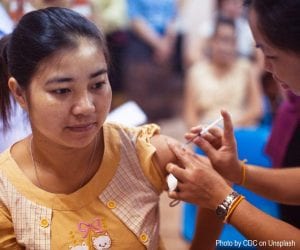Human rights stands at the crossroads of multiple issues, including, but not limited to, education, poverty, and reproductive freedom. Climate change exacerbates human rights challenges as countries and communities struggle to prepare for and recover from the effects of global warming. Each human being has an impact on the health of our planet and while we may not all contribute equally to global warming, the ramifications of our changing climate are not limited to those causing the greatest harm. This makes poverty, and its connection to both education levels and birth rates, essential to both achieving universal human rights, and to combating the dangers of climate change.
Climate Change, Poverty and Human Rights
Because there is a positive correlation between poverty and birth rates, countries that lack the resources to deal with the challenges and ramifications of climate change are often those that are also experiencing high levels of population growth. These challenges include things like a lack of water or other vital resources, or severe weather events that damage infrastructure and create large populations of displaced peoples. As climate change continues to worsen, it is estimated that over 140 million people may become displaced, particularly in Sub-Saharan Africa, South Asia, and Latin America, due to extreme weather events, droughts, and flooding.
These events create large swaths of people living without economic security. Those who are economically insecure are chronically at risk of financial crisis and of becoming unable to meet their basic needs. On an individual level, this economic instability prevents people from meaningfully participating in society or planning for the future. People can be forced to live without fundamental human rights, like shelter, water, safety, and education. On a larger scale, countries are forced to deal with the immediate issues at hand, like feeding and housing displaced peoples, and are often left unable to pull their citizens out of a cycle of poverty.
Understanding the far-reaching impact of living in poverty, the United Nations included “No Poverty” as one of their 17 Sustainable Development Goals. Included in the targets of Goal 1, “No Poverty,” was to build resilience in poor communities, aiming to reduce their “exposure and vulnerability to climate-related extreme events.”
Education, Poverty and Human Rights
There is a negative correlation between education levels and poverty, as well as a negative correlation between education levels and birth rates. Again, understanding education’s ability to raise both individuals and communities out of poverty, the United Nations created Goal 4, “Quality Education,” in the Sustainable Development Goals. Women and girls are disproportionately excluded from the education system, kept away through barriers like menstruation, the uneven distribution of household chores and responsibilities, and, in some cultures, child marriage practices. When women and girls are allowed to receive an education, they are granted more opportunities in society. It delays marriage, and women tend to have fewer children over their lifetime.
Protecting Human Rights in a Growing World
As our world population grows, achieving universal human rights is one of the most effective ways to combat the negative effects of rapid population growth. Giving women and girls equal opportunity in society and empowering them with the ability to make their own decisions lowers birth rates. This, in turn, allows for communities to raise themselves out of poverty, and advocate and prepare for the ramifications of climate change, all while combating one of its major causes—rapid human population growth.




